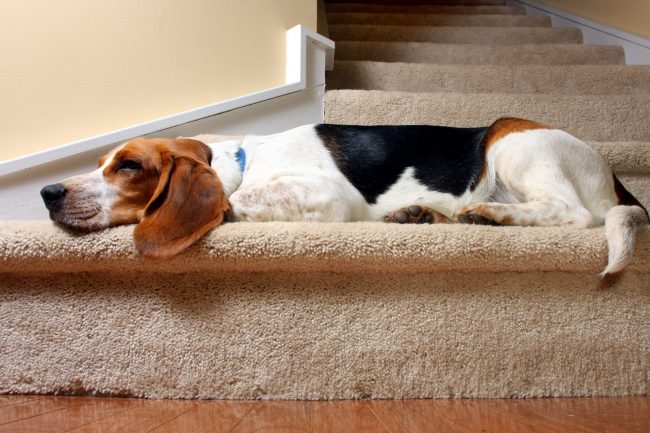Why is my dog limping?
How come my dog won’t climb stairs?
Why won’t my dog jump into the car?
The answer could be your dog is showing signs of canine osteoarthritis (OA). Take the quiz to see your dog's OA risk.
Early signs of OA
Your playful, active dog doesn’t want to slow down, but your dog will give you hints that canine osteoarthritis (OA) is starting to set in. Watch for your dog showing any of these early warning signs:1,2
- Acts more anxious, restless or irritable
- Struggles to get comfortable and frequently changes positions
- Slower to get up or sit down
- Shifts weight from side to side or front to back while standing
- Shows less interest in playing
- Hesitates before doing normal activities like walking, sitting or climbing stairs
Getting Pet Owner Involved
Denis J. Marcellin-Little
DEDV, DACVS, DECVS, DACVSMR“We’ve got to be very sensitive to what the owner sees at home. Even if the owner is not that concerned about what they see, we’ve got to probe them. We’ve got to ask them what’s going on at home, and we’ve got to never dismiss as a clinician some red flags that the owner will bring up.
“An unusual limb position, an unusual way to sleep, an unusual posture or gait most often is going to be the consequence of a painful joint that may not be diagnosed yet.”
David L. Dycus
DVM, MS, CCRP, DACVS-SA“We want to let them know on the front end this is the expectations and these are the things that we can do to hopefully prevent in some situations,
“...or at least dramatically slow down the progression, so that they may never have clinical signs that we need to manage pharmaceutically or from other options.”
Kristin Kirkby Shaw
DVM, MS, PhD, CCRT, DACVS, DACVSMR“While osteoarthritis is a potentially debilitating disease, it doesn’t always have to be, and it doesn’t have to be a scary word. We need to frame it in a positive sense and a hopeful sense and give clients the tools to help their own dog.
“And ultimately we, as veterinarians, are the advocate for the dog. And by not having these tough conversations with the client, we’re not doing our job.
Whit Cothern
DVM“Having these conversations about osteoarthritis, especially in these higher risk breeds, with the pet owner is vitally important.
“We want to loop them in on the therapies that are available. We want to have the discussions about nutrition and weight management and breed predilections.”
The participants are paid consultants for American Regent Animal Health. The opinions of these consultants may not be representative of American Regent Animal Health.
© 2020, American Regent, Inc. NP-NA-US-0343 11/2020

GROWING DOGS
including puppies and young dogs, may show occasional signs of OA that last only a few seconds. Starting veterinary management at this age is ideal to help keep cartilage healthy.

ADULT DOGS
may start to be unable to tolerate exercise and have difficulty performing activities of daily living. OA becomes more difficult to manage at this age because of worn cartilage, but veterinarians can still give dogs of this age some relief from OA.

YOUNG ADULT DOGS
can experience occasional signs that are more frequent and last longer. Veterinary intervention is critical at this age in order to slow down OA so it’s not debilitating later in life.

OLDER DOGS
experiencing OA may show the most advanced signs. If OA isn’t diagnosed and managed earlier in their lives, they may have little or no ability to move when finally diagnosed.

Main causes of OA2
OA can affect any dog – young or old, large or small – but some dogs are even more likely to develop OA because of the following:
- Genetics
- Excess bodyweight
- Lack of exercise
- Poor nutrition
While small-breed dogs are susceptible to OA, large and giant-breed dogs such as these are most commonly affected:
- Golden retrievers
- German shepherds
- Labrador retrievers
- Mastiffs
- Clinician’s Brief, Aug 2013, Canine OA, DA Canapp, DVM, CCRT, CVA, DACVSMR.
- Face validity of a proposed tool for staging canine osteoarthritis: Canine Osteoarthritis Staging Tool (COAST), T. Cachon, O. Frykman, J.F. Innes, B.D.X. Lascelles, M. Okumra, P. Sousa, F. Staffieri, P.V. Steagall, B. Van Ryssen, COAST Developmental Group, The Veterinary Journal, 235 (2018) 1-8.

